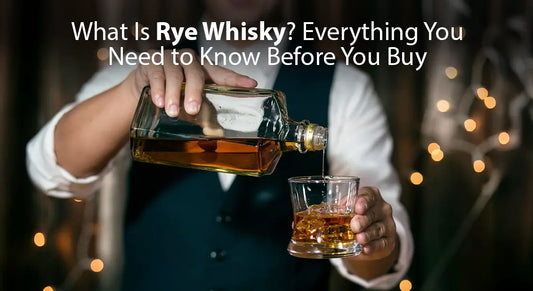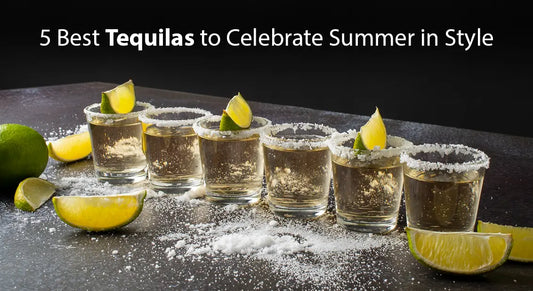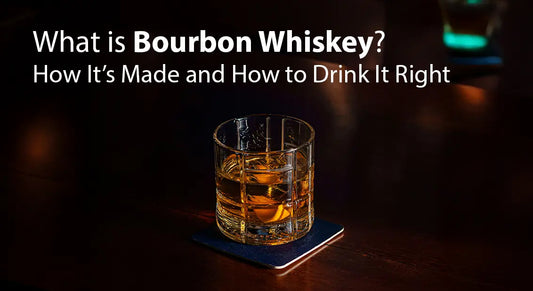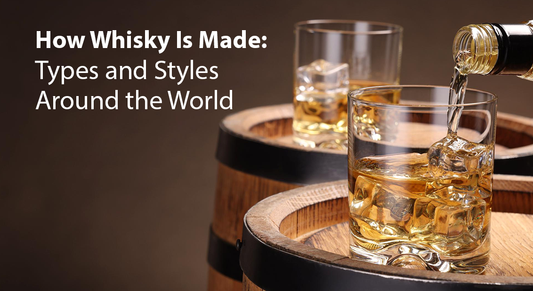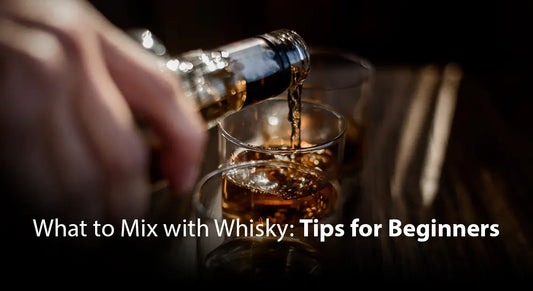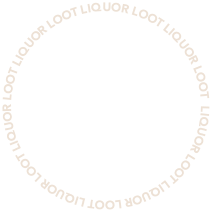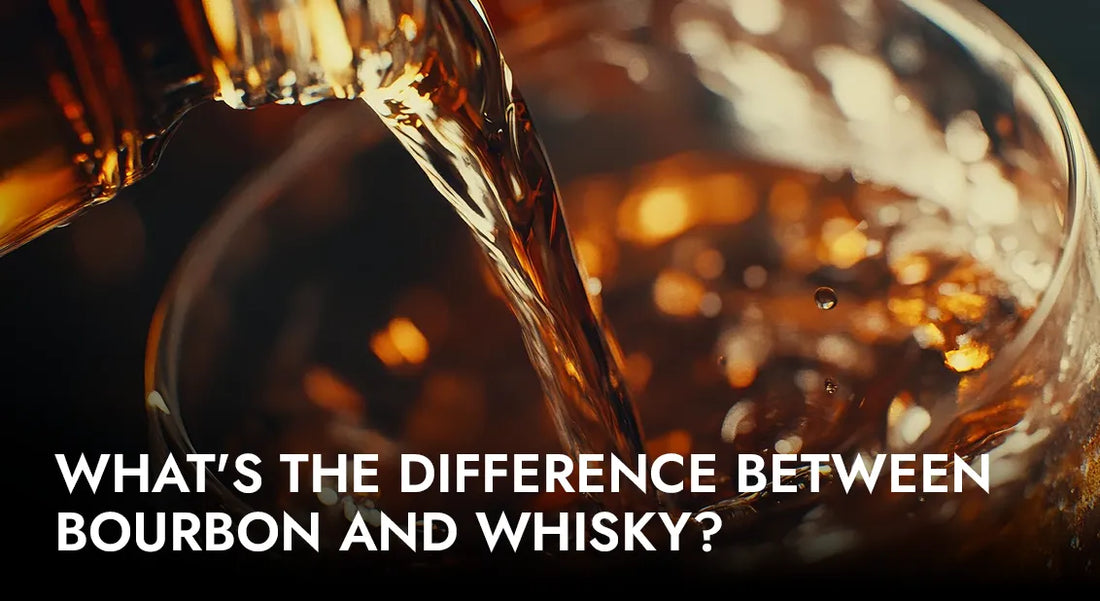
What's the difference between Bourbon and whisky?
Simply put, there is no difference. Bourbon is a style of whiskey. What makes Bourbon different from other whiskies? Read on to find out...
Whisky is a widely varied spirit, and there are many different styles around the world. Bourbon is America's spirit, just as Scotch is Scotland's. The world of whiskey can seem intimidating with its countless bottles, regional styles, and complex terminology. But here's the simple truth: bourbon is a type of whiskey, much like how champagne is a type of sparkling wine.
Understanding this is an escape to a flavourful world, from Kentucky's sweet corn-based bourbons to Scotland's smoky single malts. Whether you're new to whiskey or looking to expand your knowledge, just buy bourbon and follow this guide that breaks down everything you need to know about both, their differences, production methods, flavour profiles, and how to enjoy them. Let's find out what makes each style unique and help you discover your perfect pour. Let's start with the basics...
What is Whiskey?
Whiskey (or whisky) is a distilled alcoholic spirit made from fermented grain mash. Various grains can be used, including barley, corn, rye, and wheat. The spirit is typically aged in wooden casks, which gives it its unique and beautiful brown colour and complex flavour profile.
Key Characteristics:
-
Made from fermented grains
-
Distilled and aged in barrels
-
Minimum 40% ABV
-
Produced worldwide with regional variations
What is Bourbon?
Bourbon is a specific type, or say, style of whiskey with a distinct American originality. Think of it this way: all bourbon is whiskey, but not all whiskey is bourbon, and just like how all squares are rectangles, but not all rectangles are squares.
Key Characteristics:
-
Must be made in the USA
-
Minimum 51% corn in the mashbill
-
Aged in new, charred oak barrels
-
Sweet, smooth flavour profile
Bourbon vs Whiskey: Quick Comparison
If you’re planning to buy alcohol online in Australia, chances are you’ve seen both bourbon and whisky on offer. But before you buy whisky online or add a bourbon to your cart, it’s worth knowing how these two favourites differ. To make things simple, here’s a quick comparison in a tabular format:
|
Origin |
Must be made in USA |
Produced worldwide |
|
Main Grain |
At least 51% corn |
Varies (barley, rye, corn, wheat) |
|
Barrel Type |
New, charred oak |
Varies by style |
|
Spelling |
Whiskey (with 'e') |
Whiskey (USA/Ireland) or Whisky (Scotland/Japan) |
|
Flavor Profile |
Sweet, vanilla, caramel |
Varies widely by region |
|
Minimum Age |
No requirement (except Straight Bourbon) |
Varies by region |
Location, Location, Location
As said, for a whiskey to be called Bourbon, it must be made in the United States of America. Contrary to popular belief, it does not have to be made in Kentucky (Bourbon's spiritual home); anywhere on US soil can be Bourbon-making territory – from Alaska to Hawaii.
There’s nothing stopping non-American distilleries from producing whisky using all the techniques and ingredients of Bourbon, but they won’t get the official seal of approval. Since the 1960s by the U.S. government as a “distinctive product of the United States" – and this distinction is fiercely protected in trade agreements.
Oh, one more thing, in America, whiskey is generally spelled with the 'e', whilst in Scotland, Australia, and Japan, the spirit is called "whisky". So basically, both are the same thing.
A Brief History of Bourbon
When settlers first came from Scotland and Ireland to Kentucky, Tennessee, and Pennsylvania, they brought their distilling knowledge and abilities with them.
Like in Europe, whiskey production in the US first emerged when farmers wanted to make something of their spare produce. In America, they found that corn and rye grew in abundance, and applied the same principles they had used with malted barley back home to their excess crop. The result was Bourbon.
It’s not entirely known when the first Bourbon was made, where and by whom, but it is rumoured to have emerged in the mid-18th century, with Baptist minister Elijah Craig (who has now given his name to a Jim Beam range) said to have been one of the early innovators. Old Bourbon County, close to where Craig’s first still was established, eventually gave its name to this distinctively American style of spirit.
Bourbon’s history has not always been smooth sailing. In 1791, whiskey threatened to destabilise the nascent United States. Several distillers and drinkers took up arms when newly appointed President George Washington announced a tariff on whiskey. The tax was particularly hard on smaller distilleries in Kentucky and Pennsylvania. Though the rebellion collapsed, the duty remained extremely difficult to collect in the remote parts of the US, and distilleries were able to survive and thrive. When Jefferson became President, the tax was repealed. American whiskey was here to stay.
Bourbon never truly went out of favour, even during Prohibition (when a few distillers were allowed to keep producing for “medical” reasons), the spirit survived, and actually overtook Rye whiskey as America’s preferred tipple. After a downturn in the mid-1900s, Bourbon enjoyed a renaissance in the 1990s and has been en vogue around the world ever since. These days, there is more choice for the discerning Bourbon drinker than at any other time in history.
The Legal Definition: What Makes Bourbon Unique?
Bourbon isn't just a marketing term; it's a legally protected designation enshrined in U.S. federal law. For a whiskey to earn the bourbon label, it must meet strict requirements that govern everything from ingredients to production methods. These regulations protect the integrity of America's native spirit and ensure consistency in quality and flavor.
The Four Core Requirements:
-
Mashbill: Must contain at least 51% corn (most use 65%+), with remaining grains typically being rye, wheat, or malted barley.
-
Barrels: Must be aged in brand-new, charred oak barrels; no reusing allowed, unlike Scotch
-
Strength: Cannot be distilled above 80% ABV, barreled above 62.5% ABV, or bottled below 40% ABV
-
Location: Must be produced anywhere in the United States (not just Kentucky, despite popular belief)
Premium Bourbon Categories
-
Kentucky Straight Bourbon
Here's where things get a little tricky. "Straight Bourbon" must be aged for more than two years. If it has been aged for less than four years, it must carry an age statement. "Straight Bourbon" can also be produced anywhere in America, but Kentucky Straight Bourbon must come from the Bluegrass state. Phew, got all that?
-
Bottled in Bond
Another confusing Bourbon phrase is Bottled-in-Bond, but within this term lies an interesting period of American whiskey history.
On the eve of the 20th century, public confidence in the Bourbons was at an all-time low. Unscrupulous distillers had been adding flavour and stretching their stock through the addition of various noxious ingredients, such as iodine, tobacco, or turpentine. At this point, most Bourbon was unaged, and the additions sought to make the harsh spirit more palatable.
To counteract these practices, the federal government and a handful of honest distillers (including E.H. Taylor, now honoured with his own Buffalo Trace range) joined forces to produce the Bottled-in-Bond Act of 1897. This act offered tax incentives to distillers, and the ability to label their whiskey as “Bottled-in-Bond” – an assurance of quality – so long as they committed to producing their whiskey the right way.
The stipulations they laid out then remain to this day. Bottled-in-Bond whiskey must be:
-
The product of one distiller, at one distillery during one distilling season (January to June, or July to December).
-
At least 50% ABV.
-
Aged in a federally bonded warehouse for a minimum of four years.
At the time, bonded warehouses were literally supervised by Government Agents, who held the keys and would lock the doors every night and unlock them every morning.
To this day, Bottled-in-Bond is seen as an indication of a whiskey’s quality, and many Bourbon aficionados regard “BiB” Bourbon as some of the last great bargains of the industry.
What about Tennessee whiskey?
Tennessee whiskey goes through a unique filtration known as the Lincoln County Process. Here, the whiskey is slowly trickled through maple charcoal before being placed in the barrel for ageing. Whether this counts as "adding an ingredient" is a debate that rages on. Nevertheless, Tennessee whiskies such as George Dickel and Jack Daniel's could technically be labelled as Bourbons. They just choose not to!
Types of Whiskey Around the World
Scotch Whisky
-
Origin: Scotland
-
Main Grain: Malted barley
-
Ageing: Minimum 3 years
-
Flavour: Smoky, peaty, complex
Irish Whiskey
-
Origin: Ireland
-
Main Grain: Barley (malted and unmalted)
-
Ageing: Minimum 3 years
-
Flavour: Smooth, light, slightly sweet
Rye Whiskey
-
Origin: USA/Canada
-
Main Grain: Minimum 51% rye (USA)
-
Ageing: Varies
-
Flavour: Spicy, bold, peppery
Japanese Whisky
-
Origin: Japan
-
Main Grain: Malted barley
-
Ageing: No legal minimum
-
Flavour: Delicate, refined, balanced
Tennessee Whiskey
-
Origin: Tennessee, USA
-
Main Grain: At least 51% corn
-
Note: Could technically be called bourbon, but chooses a distinct identity
What does Bourbon taste like?
So after all this history, all this work, and all these rules, what's the end result? Well... A damn good whiskey! Bourbon is a broad church, with different mashbills, distilleries, barrel types, char levels, and ages all producing radically different final products.
Generally, though, it is a sweeter style of whiskey compared to single malt or Rye whiskey, and notes of caramel, apples, baking spice, cornbread, oak, and vanilla are common.
Flavour Profiles: Tasting Bourbon and Whiskey
The taste of whiskey varies dramatically based on grains, production methods, and ageing. Bourbon's high corn content and new charred oak barrels create its signature sweetness, while other whiskeys offer completely different experiences. Understanding these flavour profiles helps you choose bottles you'll love and appreciate the craft behind each style.
Bourbon
-
Vanilla and caramel (from charred oak)
-
Sweet corn, honey, butterscotch
-
Baking spices: cinnamon, nutmeg, clove
-
Oak, toasted nuts, toffee
-
High-rye: spicier; Wheated: softer, sweeter
Scotch Whisky
-
Islay: peat smoke, seaweed, medicinal
-
Highland: heather, honey, dried fruit
-
Speyside: apple, pear, vanilla, elegant
Irish Whiskey
-
Smooth, light, approachable
-
Vanilla cream, honey
-
Green apple, citrus
-
Creamy, buttery texture
Rye Whiskey
-
Bold black pepper, mint
-
Dark fruit: plum, blackberry
-
Earthy grain, slight bitterness
-
Assertive, drying spice
Japanese Whisky
-
Delicate, balanced, refined
-
Floral: cherry blossom, orange blossom
-
Light fruit: citrus, white peach
-
Subtle oak, sometimes gentle smoke
FAQs
Q: What's the main difference between bourbon and whiskey?
A: Bourbon is a specific type of whiskey made with at least 51% corn, aged in new charred oak barrels, and produced in the USA. Whiskey is the broader category that includes bourbon, Scotch, Irish, rye, and other styles.
Q: Does bourbon have to be made in Kentucky?
A: No. Bourbon can be made anywhere in the United States, though Kentucky produces about 95% of it. The state's climate and limestone water make it ideal, but it's not a legal requirement.
Q: How long should bourbon be aged?
A: There's no minimum age for standard bourbon. However, Straight Bourbon must be aged at least 2 years, and Bottled-in-Bond requires 4 years minimum. Most quality bourbons are aged 4-8 years.
Q: Can I add ice or water to whiskey?
A: Absolutely. Adding ice chills and dilutes the whiskey, while a few drops of water can "open up" flavors and reduce alcohol burn. There's no wrong way, drink it your way as you prefer.
Q: What makes bourbon taste sweet?
A: The high corn content (minimum 51%) provides natural sweetness, while ageing in new charred oak barrels adds vanilla, caramel, and toffee notes from the caramelised wood sugars.
Q: Is expensive whiskey always better?
A: Not necessarily. Many excellent bourbons are available at affordable prices. Price often reflects rarity, age, or marketing rather than quality. The best whiskey is the one you enjoy, regardless of cost.
The world of bourbon and whiskey offers endless discovery for every palate. From Kentucky's sweet bourbons to Scotland's smoky malts, each style reflects unique traditions and craftsmanship. Whether you're new to this spirit or a seasoned enthusiast, remember that the best whiskey is simply the one you enjoy. Start exploring different styles, trust your taste, and don't let the rules or price tags come in between. Share a glass with friends, try something new, and savour the journey. The whiskey world welcomes everyone. Here's to finding your perfect pour. Cheers!
And the best way to work out what Bourbon tastes like is to get out there and try some! We recommend perusing Liquor Loot’s finest selection of premium American whiskeys, where you are bound to find a Bourbon for you. Buy bourbon online right here and raise a toast to the true spirits of whiskey!
